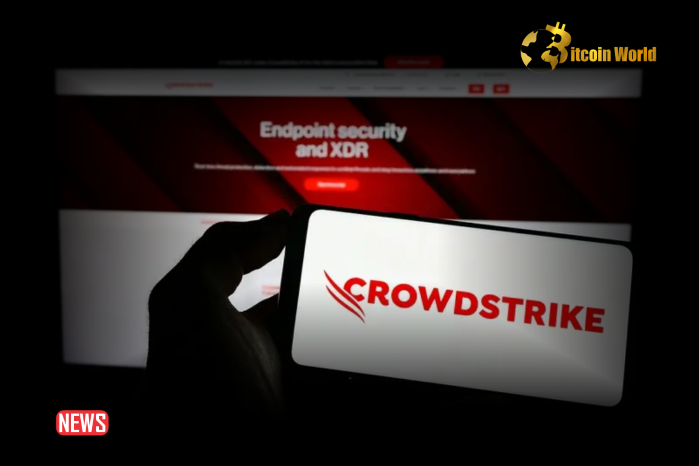In a dramatic turn of events, cybersecurity firm CrowdStrike (CRWD.O) witnessed its stock price plummet by a staggering 13% on Monday. This sharp decline extends a losing streak for the company, triggered by a significant global IT outage the previous week. But what exactly happened, and what does it mean for CrowdStrike and the wider tech landscape? Let’s dive into the details.
The Glitch Heard Around the World: What Went Wrong?
Last week, a faulty update to CrowdStrike’s security software inadvertently wreaked havoc on computers running Microsoft’s Windows operating system. This wasn’t just a minor hiccup; it was a major disruption that rippled across the internet, impacting a vast array of industries globally. Airlines, banking institutions, healthcare providers – none were spared from the widespread chaos.
Microsoft, the tech giant behind Windows, confirmed the scale of the problem, stating that approximately 8.5 million Windows devices – less than 1% of the total Windows ecosystem – were affected. While this might seem like a small percentage, the sheer number of devices and the critical nature of the affected systems led to significant disruptions.
Why Did CrowdStrike Stock Take a 13% Dive?
Wall Street analysts reacted swiftly and decisively to the unfolding situation. Several analysts downgraded CrowdStrike’s stock, primarily due to concerns about the potential financial repercussions of this major IT outage. The key worries include:
- Reputational Damage: A security company experiencing a security software glitch that causes a global outage is a significant blow to its reputation. Trust is paramount in the cybersecurity industry, and incidents like this can erode client confidence.
- Impact on New Customer Contracts: Potential new clients might become hesitant to sign deals with CrowdStrike in the immediate aftermath of such a high-profile failure. The incident raises questions about the reliability and robustness of their software.
- Competitive Advantage: Rivals in the cybersecurity space are likely to capitalize on CrowdStrike’s misfortune. This incident provides an opening for competitors to win over customers who might now be seeking alternative solutions.
- Potential Legal Battles: As businesses grapple with the aftermath of the outage, there’s a looming threat of legal action from affected customers seeking compensation for damages and disruptions.
Guggenheim analysts highlighted these concerns, stating, “We don’t believe it will materially affect renewals, at least not in the short term … However, we do think this will at least delay deal signings, if not cause some losses in closely contested deals.” This cautious outlook reflects the uncertainty surrounding the long-term impact on CrowdStrike’s business.
SentinelOne Soars: A Clear Beneficiary?
In stark contrast to CrowdStrike’s woes, shares of rival cybersecurity firm SentinelOne (S.N), opened new tab, experienced an impressive 11% surge on Monday. J.P. Morgan analysts didn’t mince words, labeling SentinelOne “the most obvious beneficiary” of what many are calling the most extensive IT outage in recent history. This highlights the competitive nature of the cybersecurity market, where one company’s misstep can be another’s gain.
Legal Storm Clouds Gathering?
Bernstein analyst Peter Weed raised another critical point: the potential for legal battles. As companies work to restore their systems and quantify the damages, the question of liability looms large. “There was a non-zero chance that legal battles will be fought after CrowdStrike’s customers get their systems up and running again,” Weed noted. The legal ramifications could add further financial strain and reputational damage to CrowdStrike.
Beyond CrowdStrike: Broader Industry Questions
The global IT outage sparked by CrowdStrike’s software glitch has ignited a broader conversation about the cybersecurity landscape and the reliance on a few key players. As services gradually returned online after Friday’s disruptions, businesses are now grappling with backlogs, delays, and even canceled operations. This incident raises critical questions:
- How can businesses prevent such widespread outages in the future? Robust testing, redundancy measures, and diversified security strategies are likely to be re-evaluated.
- Should critical software be concentrated in the hands of a limited number of companies? The outage highlights the potential risks of over-reliance on a few vendors for essential IT infrastructure. Diversification and multi-vendor approaches might gain traction.
Analyst Outlook: Damage Control vs. Sales Focus
By Monday, CrowdStrike’s shares were trading at $265.24, reflecting an 11% drop on Friday and further losses on Monday. At least six brokerages have revised down their price targets for CrowdStrike, and two have downgraded the stock’s rating to “neutral” from “buy.”
J.P. Morgan analysts succinctly summarized the challenge facing CrowdStrike: “The globally disruptive nature of this event will likely have an impact on CrowdStrike’s financial and operational performance… Time spent on damage control is time spent on not selling.” This captures the core issue – CrowdStrike must now dedicate significant resources to address the fallout, potentially diverting attention and resources from sales and business development efforts.
Looking Ahead: Navigating the Fallout
While analysts generally believe CrowdStrike will eventually recover, given its strong position in the cybersecurity industry, the road ahead is undoubtedly bumpy. The company faces immediate challenges in regaining trust, mitigating reputational damage, and navigating potential legal and financial repercussions. The incident serves as a stark reminder of the interconnectedness of our digital world and the critical importance of robust and reliable cybersecurity solutions. For CrowdStrike, the focus now shifts to damage control, rebuilding confidence, and ensuring such an incident is never repeated.
Disclaimer: The information provided is not trading advice, Bitcoinworld.co.in holds no liability for any investments made based on the information provided on this page. We strongly recommend independent research and/or consultation with a qualified professional before making any investment decisions.


